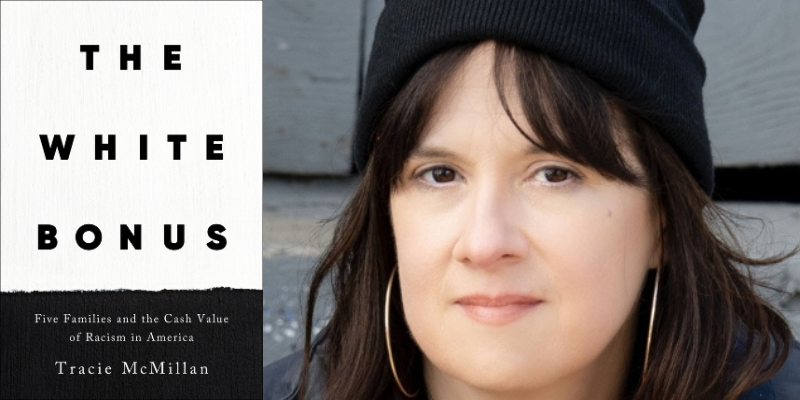Tracie McMillan on the Myth of Colorblindness
In Conversation with Whitney Terrell and V.V. Ganeshananthan on Fiction/Non/Fiction
Author and journalist Tracie McMillan joins co-hosts Whitney Terrell and V.V. Ganeshananthan to talk about the concept of the “white bonus” and how systemic bias generates white wealth not only in daily life but across generations. She references racial covenants, incarceration rates, and housing codes that continue to impact families, Black and white, to this day. She comments on the challenges of writing about her own experiences while also working as a journalist, and reads an excerpt from her new book, The White Bonus: Five Families and the Cash Value of Racism in America.
Check out video excerpts from our interviews at Lit Hub’s Virtual Book Channel, Fiction/Non/Fiction’s YouTube Channel, and our website. This episode of the podcast was produced by Anne Kniggendorf and Charlie Sheckells.
*
From the episode:
Whitney Terrell: At one point, I think your grandmother sort of described the atomic bomb as being kind of a “bonus” because it saved your grandfather’s life at the expense of many other people’s lives—but they were not white people. So, you talked about the GI Bill and the gatekeeping surrounding who got funding to go to college. Could you go through some examples of the people in your family and the other characters in the book receiving these bonuses?
Tracie McMillan: The stuff that comes down from family, largely, was stuff like employment discrimination benefiting your parents and grandparents. It was legal until the ’60s to discriminate for employment. I have a construction worker dad. He got his job through his father-in-law, who got into the union before it was integrated. So, even though that’s a pretty hard scrabble income, it’s what that family described as stabilizing them because he got into the union. That’s because he had ties to this guy, and the guy he had ties to got the job because he was white, that sort of thing.
Credit discrimination—White people being given more credit and more sort of generous terms of credit. You see that trouble with mortgage lending. Often that stuff still happens a lot, even though it’s illegal. In criminal justice, I talk not just about white bonus but deference to white people, particularly to white families and to white middle class and above men. I have a character who decided in 1994 it would be a good idea to go deal LSD at school, right? He gets caught. He threatens the snitch. So he ended up with extortion and larceny charges in 1994. This is in the height of punitive drug laws in a tough-on-crime district, and he gets given a second chance. How do you get that second chance? There’s deference to him and his family by giving them the second chance, but also his dad was an engineer. How did his dad become an engineer? Well, he studied when he was in Buffalo working at Kodak because Kodak paid for his tuition. Kodak has a decades-long history of employment discrimination from the ’60s through at least the 2010s or 2000s. Looking at how stuff snowballs and then trickles down, it’s all these little things that just keep adding up. By the time it gets to Gen X and beyond, stuff is really built up.
V.V. Ganeshananthan: You phrase that in the book—really helpfully—as a direct payment and then compounding interest, which helped me to understand the way you were talking about it. For our listeners, at the back of the book, there are some calculations there that pertain to the characters. Examples of things like the financial benefit of avoiding incarceration or foster care, etc. You chose particular families and characters to write about—you had to get their consent to do that—and that sounds like a complex set of questions to be asking.
I remember, in college, I wrote a story about self-segregation. I was a Harvard undergraduate and went looking for an all-white blocking group, which is a group of students who choose to live in the same residential college, not necessarily the same room, but the same residential college. I asked one if they would talk to me, and they said, “Absolutely not.” They did not want it. They didn’t want it recorded. How do you get people to talk about this kind of very personal stuff? The characters that you chose, the people that you chose to focus on, really defy stereotypes. To use another white-privilege internet-standard term, they’re not Karens. So, could you talk a little bit about the specific people that you profile in these sections? How did you find them? How did you develop those relationships?
TM: Sure, I’ll go through chronologically. In the book, chapter two is about Katrina, who is the union nurse with SEIU (Service Employees International Union) in Pittsburgh. She grew up in a white working-class environment and is the daughter of the construction worker. I found her, ultimately, through her union. I had initially thought I was just going to go out and find a restaurant worker, and I could not get anyone to talk to me.
I spent six weeks in Pittsburgh, and I did not have any more time to spend on casting. So I was like, I’ll go through a group. And SEIU does really interesting racial consciousness education with their members. They were on board to have me do that work. They connected with Katrina, and they just let me go. There wasn’t any handling or any of that stuff because it wasn’t about their campaigns or anything.
All the rest of it just showed up. All I knew was that Katrina was a white nurse in Pittsburgh—a majority white city, which is unusual in this country—and that she was thinking more about race. So, all the other stuff that fleshes out her character just happened to be her life. It just so happens that her best friend is also a nurse, is Black, and had a very different path into nursing than Katrina did. It just so happens that Katrina’s dad worked in the construction trades, which just so happened to be the site of a massive integration protest in the ’70s around integrating the construction trades. All that stuff gets brought in and lets me talk about race and labor in a way that I thought was really interesting and fun for me to do.
Transcribed by Otter.ai. Condensed and edited by Mikayla Vo. Photograph of Tracie McMillan by Sarah Rice.
*
The White Bonus: Five Families and the Cash Value of Racism in America • The American Way of Eating • City Limits
Others:
Racism without Racists: Color-Blind Racism and the Persistence of Racial Inequality in America by Eduardo Bonilla-Silva • “The Man Who Made the Suburbs White,” by Mark Dent | Slate • The King of Kings County by Whitney Terrell • The Sum of Us: What Racism Costs Everyone and How We Can Prosper Together by Heather McGhee • Men We Reaped by Jesmyn Ward • Heavy by Kiese Laymon • Fiction/Non/Fiction Season 1, Episode 24, Part I: “Jess Row and Timothy Yu on Whiteness and Writing About Race” • Fiction/Non/Fiction Season 1, Episode 24, Part II: “Jess Row and Timothy Yu on Learning From Writers Who Write About Race” • “What’s Your Bonus” | Thewhitebonus.com




















